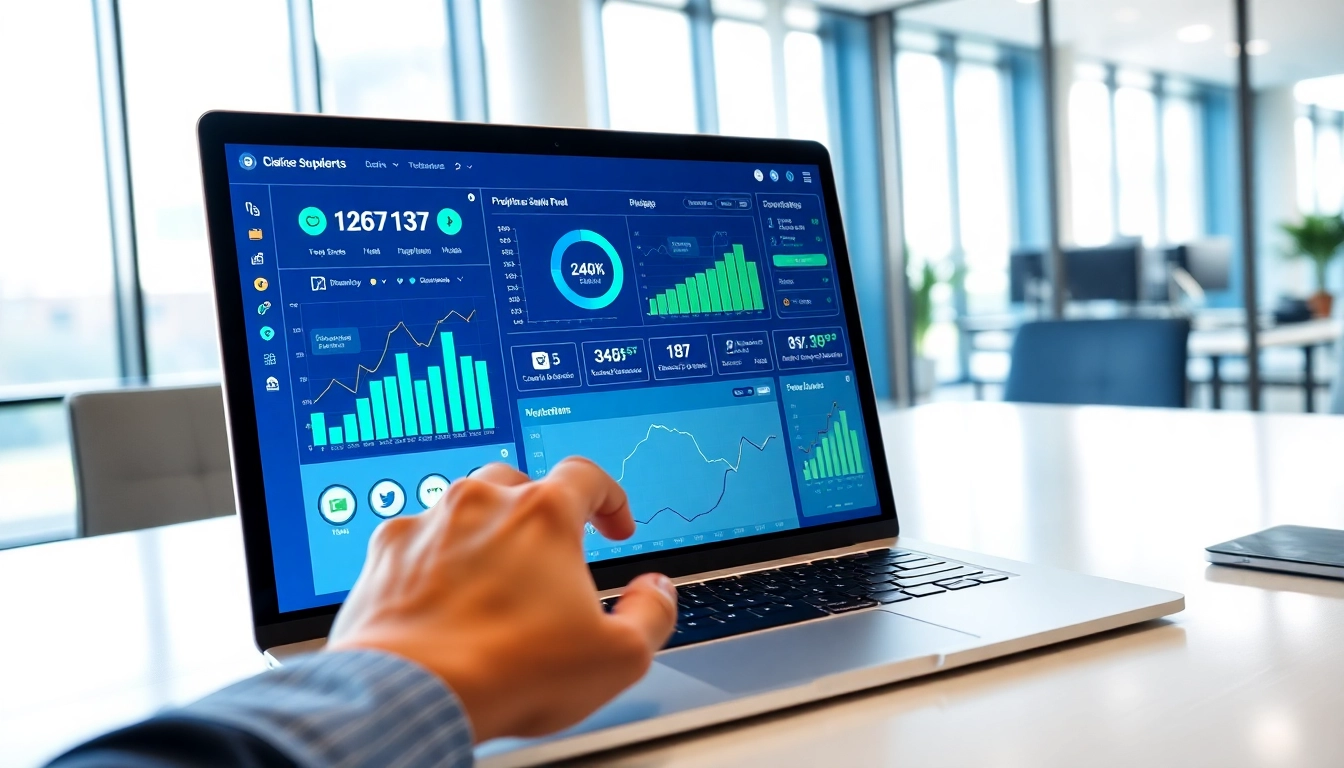Elevate Your Brand Identity with Namelix: Strategies for Modern Logo Design

Understanding Namelix and Its Role in Logo Generation
What is Namelix?
Namelix is an advanced logo generation tool that leverages artificial intelligence to create unique and customizable logos tailored to your brand’s needs. It streamlines the logo design process, allowing users—be they entrepreneurs, startups, or established businesses—to quickly develop visual identities that resonate with their target audience. With a user-friendly interface, Namelix enables users to input keywords relevant to their business, and it spits out diverse logo options based on those inputs, effectively transforming abstract ideas into concrete visual representations. This optimized approach not only saves time and resources but also aligns well with modern branding strategies that emphasize agility and creativity.
How Namelix Works: A Step-by-Step Guide
The process of creating a logo with Namelix is intuitive and straightforward. Here’s a step-by-step guide to get you started:
- Keyword Input: Begin by entering keywords that reflect your business, product, or service on the namelix website. These keywords will serve as the foundation upon which your logo is built.
- Style Selection: After submitting your keywords, you’ll be prompted to choose a style preference for your logo. Options may vary from minimalistic to playful, depending on your brand’s identity.
- AI-Generated Options: Namelix utilizes AI algorithms to analyze your inputs and generate multiple logo concepts. You’ll receive a range of logos that embody different styles, colors, and typography.
- Customization: Choose a logo that resonates most with you, and enter a customization mode where you can tweak aspects like colors, fonts, and layout to make it truly unique.
- Download: Once satisfied with the design, download your logo in various formats suitable for both print and digital use.
Benefits of Using Namelix for Your Brand
Utilizing Namelix for logo creation has several advantages:
- Speed: Generate logos in minutes instead of days or weeks, enabling faster branding decisions.
- Cost-Effective: Access professional designs without the need for expensive graphic designers, making it ideal for startups and small businesses.
- Variety: Explore a wide range of design possibilities that you might not have considered, enhancing creativity in your branding.
- User-Friendly: Even those without design experience can navigate the tool easily, thanks to its intuitive interface.
- AI Assistance: Harness the power of AI to pinpoint trends and preferences in design, ensuring your logo meets contemporary standards.
Best Practices for Logo Design Using Namelix
Choosing the Right Colors and Fonts
The visual appeal of a logo is significantly influenced by its color scheme and typography. Here’s how to choose effectively:
- Understand Color Psychology: Different colors evoke various emotions. For example, blue often conveys trust and professionalism, while red signifies excitement and passion. Choose colors that align with your brand values.
- Consider Font Readability: Select fonts that are not only visually appealing but also easy to read across different platforms. Avoid overly intricate fonts that might confuse or deter potential audiences.
- Be Consistent: Ensure that your color palette and font choices align with your overall brand identity and are consistent across all marketing materials.
- Experiment with Combinations: Don’t hesitate to test different combinations of colors and fonts using Namelix’s customization features to find the perfect match.
Designing for Different Platforms
In today’s digital landscape, a logo must perform across various platforms. Here’s how to ensure your logo shines universally:
- Responsive Design: Create logos that can be effectively resized and adapted, maintaining visual integrity on websites, mobile applications, and social media profiles.
- Versatile Formats: Download logos in multiple file formats (e.g., PNG, SVG, JPG) to ensure compatibility with both digital and print media.
- Testing: Preview how your logo looks on different backgrounds and devices using Namelix’s tools, making necessary adjustments based on the outcomes.
- Scalability: Design with scalability in mind; ensure that even smaller versions of your logo—like favicons or social media icons—remain clear and recognizable.
Common Mistakes to Avoid in Logo Creation
Successful logo creation requires avoiding common pitfalls:
- Overcomplication: A logo should be simple and memorable. Avoid cluttering your design with too many elements.
- Lack of Relevance: Ensure your logo reflects your business’s ethos and message. A disconnect can lead to confusion about your brand identity.
- Neglecting Feedback: Don’t design in a vacuum. Gather opinions from your target audience or peers to identify any shortcomings in your design.
- Ignoring Trends: While it’s crucial to have a timeless logo, not staying updated with design trends can result in an outdated image. Aim for a balance between classic and contemporary.
Case Studies: Businesses That Thrived with Namelix
Startups That Used Namelix Effectively
There are numerous startups that utilized Namelix for their logo design, catapulting them into the market with compelling visual identities. For example, a tech startup focusing on cybersecurity leveraged Namelix to create a sleek, modern logo that immediately communicated trustworthiness and cutting-edge technology. The logo not only helped establish their brand identity but also aided in their marketing efforts, leading to significant customer acquisition in their initial phases.
Transformations: Before and After Namelix
One of the compelling aspects of using Namelix is the dramatic transformation it can bring to a brand’s visual identity. Consider a local coffee shop that originally operated with an unpolished, generic logo. After using Namelix, they obtained a cleaner, more vibrant logo that incorporated coffee beans and warm colors. This new identity elevated their storefront and digital presence, sparking interest and engagement from the community.
Industry-Specific Logo Design Successes
Namelix has shown significant versatility across various industries. For instance, a wellness brand focusing on organic products successfully utilized the platform to develop a logo that emphasized nature through earthy tones and elegant fonts. This design captured the essence of their business, attracting a specific demographic interested in health and sustainability.
Advanced Features of Namelix for Competitive Branding
Leveraging AI for Custom Logo Design
The most significant advantage of Namelix lies in its advancement in AI technology for logo design. Namelix tailors logo suggestions based on input keywords and stylistic preferences, ensuring that every generated option is uniquely suited to the user’s vision. This level of customization is a game-changer, as it offers brands an edge in a saturated market.
Integrating Namelix with Brand Development Tools
To maximize the potential of your logo, integrating Namelix with other branding tools can be beneficial. For instance, using a content management system (CMS) or social media planner alongside your logo design can ensure cohesive branding. Tools like Canva and Adobe Spark allow you to create marketing materials that match your new logo, ensuring that all aspects of your branding are harmonized.
Measuring Success: Metrics for Logo Performance
After launching your logo, it’s crucial to measure its effectiveness through key performance indicators (KPIs):
- Brand Recognition: Survey customers to assess their recall and recognition of your brand.
- Engagement Metrics: Monitor social media engagement and website traffic pre-and post-logo launch to gauge impact.
- Customer Feedback: Utilize feedback forms and polls to collect qualitative data on perceptions of your logo.
- Sales Performance: Analyze sales performance before and after the logo redesign to identify any correlations.
Future Trends in Logo Design and Branding
The Evolution of Logo Design Tools
Logo design is continuously evolving, and tools like Namelix are at the forefront of this evolution. Future trends will likely include more emphasis on AI-driven personalization, enabling businesses to create logos that are not just unique but also adaptable to changing market dynamics. The integration of augmented reality (AR) in logo demonstrations may also become prevalent, allowing brands to showcase how logos function in real-world environments.
Personalization and User Experience in Branding
As consumers seek more personalized experiences, branding will need to follow suit. Logos that can adapt to user interactions—such as changing colors based on the time of day or user preferences—will become more common. Namelix’s capabilities may evolve to include features that allow dynamic logo variations based on user data, enhancing the personal connection consumers feel with a brand.
How Namelix is Shaping the Future of Logos
Namelix is not merely a logo generator; it’s a part of the ongoing dialogue about how we define and create brand identities. By harnessing the power of artificial intelligence and user customization, it’s paving the way for a future where every business, regardless of size or budget, can have access to professional-quality logo design. As technology evolves, so too will Namelix’s offerings, ensuring that businesses are equipped with the tools needed to thrive in an ever-competitive landscape.








